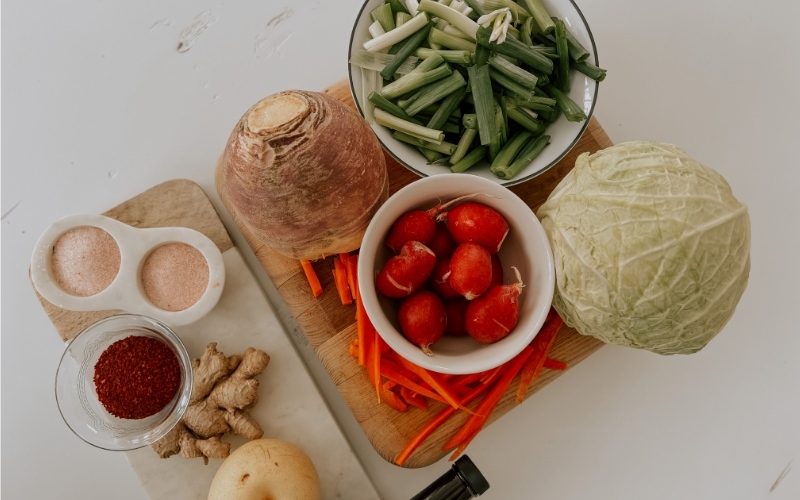Good news, kimchi is all the rage! And to celebrate, we have a tasty and original recipe made from seasonal local vegetables, such as turnips!
What is kimchi?
Kimchi is a fermentation of spicy vegetables, traditionally of Korean origin. The vegetable base typically used is napa cabbage, carrots, and daikon radish. Then to season and enhance everything, ginger, garlic, and Korean pepper, known as gochugaru, are used. This pepper is moderately pungent, with a delicately fruity and smoky flavour. Some recipes add fish sauce (in our vegan recipe we replaced the fish sauce with vegan Worcestershire sauce). The mixture is then left to ferment (this is called lacto-fermentation), which develops its irresistible tangy flavour. It also helps prolong the mixture’s shelf life.
In Korea, kimchi is served with the majority of dishes—both as a starter and as a condiment. It’s tasty served in a variety of ways . . . with rice, mixed into a protein bowl, in a sandwich, in Asian dishes, with eggs, etc. You can even use the liquid to make a vinaigrette!
Full of benefits
Kimchi was originally invented as a means of keeping vegetables fresh and preserving their nutrients during the long, cold Korean winters. However, the benefits of fermentation are not limited to this. In addition to helping with preservation, the bacteria that grow as a result of fermentation synthesize new nutrients, such as vitamin C and B. Carbohydrates naturally present in food are then processed by these bacteria. Kimchi is a recipe high in fibre and low in calories.
Kimchi is absolutely delicious! The flavours that develop during fermentation thanks to the mixture of vegetables, herbs, and spices create new aromas that are so tasty. The robust and rich taste of kimchi is sometimes surprising the first time you try it, but you’ll soon get used to it and will be asking for more!
Making your own kimchi at home
There’s nothing simpler than making kimchi. To help get you started, here’s a recipe that features local vegetables, such as turnips and red radishes.
Prep time: 1h30
Maceration time in jars: 5 days
Makes: 2 500 ml jars
Ingredients:
- 1 small green cabbage, roughly chopped (1 1\2-inch pieces)
- 2 carrots, julienned
- 1 small turnip, thinly sliced with mandolin
- 6 green onions, cut into 2-inch-long pieces
- 5 red radishes, thinly sliced with mandolin
- 2 tbsp. salt

In a large bowl, combine the cabbage and turnip. Mix with the salt and massage the vegetables with your hands so that the salt coats each piece. Next, press the vegetables to the bottom of the bowl and add a heavy plate or pan on top to squeeze them and help get the water out. Let stand for 45 min.
Seasoning:
- 1 Asian pear, peeled and cut into cubes
- 2 inches of fresh ginger, cut into pieces
- 5 garlic cloves, minced
- 1 tbsp. vegan Worcestershire sauce
- ¼ cup Korean gochugaru pepper
In a food processor, add the Asian pear, ginger, garlic, and Worcestershire sauce. Pulse until a homogeneous paste is obtained. Add the Korean pepper (gochugaru).
Before assembling everything, make sure to rinse the cabbage and turnip well to remove the salt. This step is important because otherwise the kimchi will be much too salty. Once you’ve rinsed the vegetables, drain them. Next, combine the vegetables, the remaining ingredients, and seasoning paste. Mix with hands (make sure to wear gloves) or with tongs. Finally, transfer the mixture into glass jars; you will need two 500 ml jars. Now it’s time for the fermentation to begin! Close the lids (not too tightly!) and store the jars in a dark cabinet for 5 days. After this fermentation period, you can keep the kimchi in the fridge for up to 1 month.

